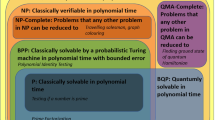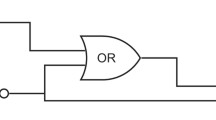
Overview
- Encourages students to embrace uncertainty over the daily classical experience, when encountering quantum phenomena
- Uses narrative to start each section with analogies that help students to grasp the critical concept quickly
- Uses numerical substitutions, accompanied by Python programming, as examples in teaching all critical concepts
Access this book
Tax calculation will be finalised at checkout
Other ways to access
About this book
- Encourages students to embrace uncertainty over the daily classical experience, when encountering quantum phenomena;
- Uses narrative to start each section with analogies that help students to grasp the critical concept quickly;
- Uses numerical substitutions, accompanied by Python programming and IBM-Q quantum computer programming, as examplesin teaching all critical concepts.
Similar content being viewed by others
Keywords
Table of contents (30 chapters)
-
Front Matter
-
Linear Algebra for Quantum Computing
-
Front Matter
-
-
Quantum Computing: Gates and Algorithms
-
Front Matter
-
Authors and Affiliations
About the author
Hiu Yung Wong is an Assistant Professor and Silicon Valley AMDT Endowed Chair in Electrical Engineering, San Jose State University. He received his Ph.D. degree in Electrical Engineering and Computer Science from the University of California, Berkeley in 2006. From 2006 to 2009, he worked as a Technology Integration Engineer in Spansion. From 2009 to 2018, he was a TCAD Senior Staff Application Engineer in Synopsys, during which he received Synopsys Excellence Award in 2010. In 2021, he received the NSF CAREER award and the Newnan Brothers Award for Faculty Excellence.
His research interests include the applications of machine learning in simulation and manufacturing, cryogenic electronics, quantum computing, reliability simulations, wide bandgap devices (such as GaN, SiC, Ga2O3, and diamond) simulations, novel semiconductor devices design, and Design Technology Co-Optimization (DTCO). His work has produced 80 papers and 10 issued patents.Dr. Wong is a co-PIof an NSF NRT grant for quantum computing education and research, including the creation of a Quantum Technology Master Program at San Jose State University.
Bibliographic Information
Book Title: Introduction to Quantum Computing
Book Subtitle: From a Layperson to a Programmer in 30 Steps
Authors: Hiu Yung Wong
DOI: https://doi.org/10.1007/978-3-030-98339-0
Publisher: Springer Cham
eBook Packages: Engineering, Engineering (R0)
Copyright Information: The Editor(s) (if applicable) and The Author(s), under exclusive license to Springer Nature Switzerland AG 2022
eBook ISBN: 978-3-030-98339-0Published: 24 May 2022
Edition Number: 1
Number of Pages: XV, 300
Number of Illustrations: 2 b/w illustrations, 68 illustrations in colour
Topics: Circuits and Systems, Programming Techniques, Quantum Computing



